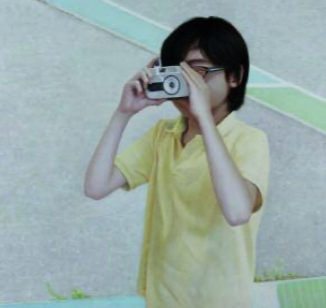Kaoru Usukubo
Crystal Voyage
We find ourselves looking at paintings by a young Japanese artist who has executed them using the techniques of the old masters—a time-consuming, almost “anachronistic” painting technique. It is painting of the highest precision and sensitivity, so vivid that the motifs seem to step out of the picture. The fact that we are fascinated by this technically brilliant painting is wonderful and particularly appealing, but this appeal should not obscure the fact that Kaoru Usukubo’s artistic expression and conceptual strength go deeper.
We find ourselves looking at paintings by a young Japanese artist who has executed them using the techniques of the old masters—a time-consuming, almost “anachronistic” painting technique. It is painting of the highest precision and sensitivity, so vivid that the motifs seem to step out of the picture. The fact that we are fascinated by this technically brilliant painting is wonderful and particularly appealing, but this appeal should not obscure the fact that Kaoru Usukubo’s artistic expression and conceptual strength go deeper.
The artist, who now teaches at Tokyo University of the Arts, was born in Tochigi, Japan, in 1981 and thus belongs to a young generation of artists who are engaged with the lively trends set by such diverse artists as Leiko Ikemura (1951) and Yoshitomo Nara (1959) for the development of contemporary Japanese painting. This older generation was already working in the 1980s with motifs that drew on the virtual world of digital images as well as the comics and manga of a subversive youth culture that reacted critically and ironically to Japanese conventions.
It is striking that childlike figures appear repeatedly in this painting: children who are alone and rarely come into contact with the outside world. Children with closed eyes, standing rooted to the spot—thoughtful, melancholic. Perhaps because they “raise a silent accusation against a world that could leave them so alone,” as Stephan Trescher puts it.[1]
In Usukubo’s paintings, we encounter only children who seem strangely absent—introverted, quiet beings who appear to be entirely on their own. With their gaze averted or their eyes closed, their attention is focused entirely on their own world, from which adults—and thus we as viewers—are excluded. They often appear larger than life, as if they wanted to capture our attention entirely for themselves and their play, unlike in reality. Kaoru Usukubo thus refers to Japanese traditions while also engaging with the increasingly sophisticated visual worlds of films and computer games. Her art thus reveals a precarious relationship between real, three-dimensional reality and the artificially generated space of virtual reality. As viewers, we are tempted to assign meaning to things, to uncover their stories. But Usukubo’s images remain enigmatic.
Before Usukubo created her new series, which we are showing with the large triptych and in the gallery, she painted pictures such as “Unidentified Place Logist” (2008) and “He can’t remember her name” (2008). It is an artificial world with folded paper animals, planes, and flowers. In the eyes of children, it becomes a wonderland. A glance through a circle or the lens of a camera is enough to make it what it could be: “Either a classroom or a harbor with white sailboats,” according to one of Usukubo’s picture titles. But even the seemingly poetic, colorful, and peaceful world of her earlier paintings exists only in the form of paper. The children in her pictures are alone, in school uniforms, mostly in closed rooms. Only their hair, which winds upward like tentacles, reveals a certain untamed individuality. Nature—in the sense of a romantic projection—as a free space and source of inspiration for the human spirit and as a place to finally let off steam, exists here only as a reference in the form of folded art products. From the outset, “real nature” seems unreal, distant—like a fantasy—in Usukubo’s paintings. The sea, the beach—a childhood dream.
After the Fukushima disaster, however, “nature” shows a different face in her paintings—rugged and forbidding, dark, overshadowed by a calamity that has already befallen us or may yet befall us. “The Proof of Prophecy …”. This major work from her new series is accompanied by four smaller works in our exhibition. “2 to 3,” for example, shows a greeting card with the motif of a lush bouquet of flowers, as we know them from the 19th century. Such depictions are still particularly popular in Japan today. But what Usukubo shows us here is not the beautiful side of a gift item. Rather, she is interested in its inner life, which, with its crumpled and torn lilac-colored lining, could be another subtle metaphor for a broken, lost world. People no longer appear in these images, not even children. The lonely island remains lonely—without vegetation, without child visitors who stumbled upon it voluntarily or involuntarily and left their toys behind.
What we see before us is art that, perhaps precisely because of its subtle breaks, contradictions, and gaps, refuses to deny the brutal consequences of a reality that is no longer virtual through superficial harmony.
[1] Stephan Trescher, “Ein Porträt des Künstlers als junger Hund” (A Portrait of the Artist as a Young Dog), in: Yoshitomo Nara – Lullaby. Supermarket
(Verlag für moderne Kunst, Nuremberg 2001) p. 73 f.
Curated by: Dr. Andrea Jahn
